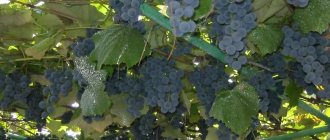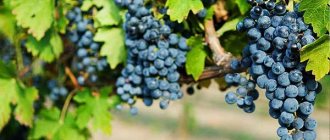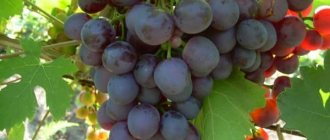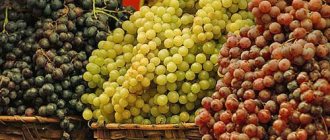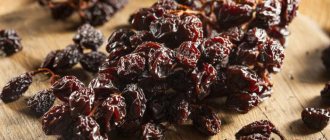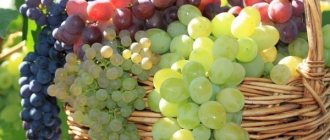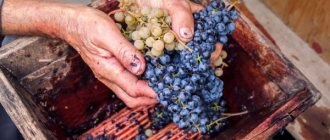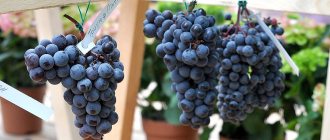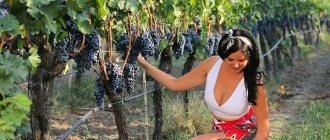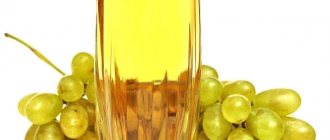Grapes are one of the berry crops loved by many people. Some people like to enjoy fresh berries. Some people prefer raisins. Grapes make excellent wines and delicious juices.
Many gardeners willingly grow grapes on their plots. Although this plant loves warmth, they learned to cultivate it in the northern regions.
Breeders also do not ignore this crop. Thanks to their work, new varieties of this wonderful berry are appearing.
Grapes are divided into 2 directions:
- Table (consumed fresh).
- Wine (technical).
There are approximately 5,000 varieties of grapes. About 100 are for wine purposes. In industrial winemaking, only 30 are used.
To make wine at home, winemakers use any material. But it is not for nothing that this berry is divided into technical and table.
In this article we will talk about the features of technical varieties. What are their differences from table species?
How technical grapes differ from the rest
- Wine varieties are more unpretentious to grow. Less demanding on soil and climate than table species. Among the technical varieties there are more frost-resistant varieties.
- Industrial grapes are less susceptible to various diseases and pests. This means that it requires less treatment with chemicals.
- Wine berries contain much more juice (80 - 85 percent) than table fruits.
- Technical berries are not as sweet as table grapes.
- Clusters of industrial grapes are smaller than clusters of table grapes.
- The wine berries themselves are smaller than table grapes.
Wines and their features
The following drinks are produced in Abrau-Durso:
- "Millesims". Particularly high-quality wines made from the best must (cuvee) and first-press grape juice from the most successful harvest. So-called “millennial” years occur approximately once every five years.
- "Imperial". This is a collectible Russian wine, similar to the French grand cru. Made from grapes that are collected from the best sites. The highest quality of this wine is confirmed by gold and silver medals awarded at international tasting competitions - Decanter, Mundus Vini, IWC, IWSC.
- Brut d`Or Blanc de Blancs. Premium sparkling Russian wine made from selected white grapes. It has a very elegant and subtle taste that all Chardonnay lovers adore.
- Victor Dravigny. This is the only personalized collection from this manufacturer. Named after the famous French winemaker, who in 1905 was the main champagne grower in Abrau-Durso. It was he who brought the classic technology of sparkling wine production to perfection.
- "Specific department". Yes, this is also the name of sparkling wine. The same drink was served at a gala dinner held in honor of the tercentenary of the House of Romanov in 1914. Modern technologists have restored the historical recipe and appearance of those bottles.
- "Russian champagne." This is the name of the most popular collection of the Abrau-Durso wine house. Many people are familiar with these dark green bottles with a black diamond-shaped label. Excellent taste and balanced aroma made the drink incredibly popular.
- Abrau Light. New line of carbonated wine drinks. It was created in 2014. Thanks to their rich, bright hue, floral aroma and fruity notes, these drinks are loved by many.
- Wine "Abrau". This line consists of five dry table wines of the highest quality - a blend (dark and light), cabernet, chardonnay and riesling.
- Foliage. In 2010, the production bought a champagne house called Chateau d'Avize, so the first French champagne appeared in the collection of lines. It is organic - with a minimum amount of sulfur, using double fermentation technology, made from grapes grown in special areas and taking into account the lunar calendar.
Since Abrau-Durso is one of the main wine producers in Russia, it would be possible to list drinks and their advantages for a long time. But one thing can be stated with confidence: if you want high-quality and refined alcohol, you can safely make a choice in their favor.
Requirements for grape varieties for wine production
- For normal wort fermentation, there must be more sweetness in the juice than acid. If the raw material is too acidic, you will have to add water. And this worsens the quality of the wine.
Interesting! Many winemakers in the south of Russia and the Caucasus republics consider this wine to be defective.
- For wine to have a beautiful color, there must be enough coloring substances in the berries.
- Industrial fruits must have a pleasant aroma and taste. This also affects the quality of the wine.
- Grape juice for winemaking must have a suitable chemical composition. This is influenced by the amount of solar heat during the ripening of the crop. The soil must also be suitable for growing grapes.
It’s not for nothing that professional winemakers use raw materials that are grown in a certain area.
"Burnier"
The winery known by this name is located in the Natukhaevskaya village, between Novorossiysk and Anapa. It was founded in the early 2000s by a married couple of winemakers, Marina and Renaud Burnier.
This is an ideal place for growing grapes, as there are soils with a high clay content (ideal for red varieties) and rocky, marl soils (excellent for white varieties).
Chardonnay, Viognier, Pinot Gris and Blanc, Yellow Muscat, Merlot, Cabernet Sauvignon and Franc, Syrah, Malbec, and also Krasnostop grow here. The latter is an old Russian red grape variety that is very rare. But DOMAINES BURNIER revived it again.
The collection is represented by the following Russian wines:
- Burnier Lublu. Gastronomic wine served with black caviar, sea fish, asparagus, poultry and foie gras.
- Merlot. An exquisite drink with the aroma of cherry and roasted cocoa beans. Served with sharp cheeses, red and white meats.
- Cabernet Sauvignon. Complex wine aged 18 months. Tart, with a long aftertaste. Ideal for grilled dishes, meats and cheeses.
- Krasnostop. It has a rich aroma of ripe fruit with hints of prunes and raisins. Suitable for lamb and game.
It is important to note that drinks from this manufacturer are produced in limited quantities.
Popular grape varieties for making white wine
To obtain white wine, the juice of white technical grape varieties is used. The shade of the fruits of these plants ranges from golden yellow to greenish. Therefore, they are conventionally called white.
Riesling
One of the oldest white grape varieties. Was bred in Germany. The juice of its berries produces high quality wines. Riesling is a worthy competitor to the famous French white brother - Chardonnay.
- Riesling ripens in mid-autumn. It takes about 4.5 months until full ripeness;
- The berries are green-yellow, round, not large. The bunch weighs up to 100 grams;
- juice contains about 18% sugar;
- The plant can withstand temperatures down to – 20°C.
Attention! Riesling produces a good harvest in any soil. But the best results are obtained on calcareous soil.
The disadvantage of this variety is its instability to diseases.
Chardonnay
This technical variety was bred in France. Chardonnay, the main variety for making sparkling wines.
Many experienced winemakers say that Chardonnay cannot make bad wine.
- The harvest ripens in 4.5 months;
- the clusters are not dense, the weight reaches 1 kilogram;
- the berries are greenish-white with a golden tint, oval in shape;
- fruits contain about 18% sugar;
- Plant resistance to freezing down to – 20°C.
Need to take into account! Chardonnay tolerates lack of water well. But excessive moisture leads to rotting of the berries.
This grape is not very resistant to fungal diseases.
Bianca
The Hungarian variety Bianca is the result of crossing Chasselas Bouvier and Villars Blanc. Bianca's juice is very sweet. Therefore, it is often mixed with the juices of more acidic grapes. So that the wine does not turn out cloying.
- The Bianca harvest matures in 4 months;
- fruits are slightly oval, yellow-green;
- berries accumulate up to 28% sugar;
- a bunch in the shape of a cylinder, weighing about 100 grams;
- the vine does not freeze up to – 27 degrees;
- The bush perfectly resists Mildew, Oidium, and Gray Rot.
Attention! Even fully ripe Bianca berries, remaining on the vine, do not wither for a long time.
Varieties with different berry colors
The color of grape berries is very diverse. It depends on the amount of coloring pectin in the skin of the fruit and can range from almost white to blue-black. On this basis, all varieties are divided into three main groups:
- white;
- black;
- red.
One of the characteristic features of a grape variety is the color of its berries.
White
The berries of white grape varieties are actually light green in color. Moreover, the shade of color depends not only on the variety, but also on the growing conditions. Sunlight has a particularly strong effect on the color intensity of fruits. To enhance its effect, many winegrowers remove part of the leaves during fruit ripening. When carrying out this procedure, you need to remember that thinning too early can lead to sunburn on the berries and complete or partial loss of the harvest.
More than half of all grape varieties have white berries. These include:
- Agadai;
- Augalia;
- Bazhena;
- White miracle;
- Galahard;
- Long awaited;
- Karaburn;
- Liana;
- Moscow white;
- Mascot;
- Citrine;
- Sabbat.
Photo gallery: popular varieties of white grapes
Black
Black grape varieties are very popular among gardeners all over the world. They contain a large amount of antioxidants that have a beneficial effect on human health. Black grapes are less common than white ones. However, it can be seen in almost any vineyard. The following varieties are especially famous:
- Academician Avidzba (In memory of Dzheneev);
- Anthracite (Charlie);
- December;
- Fun;
- Red;
- Moldova;
- Odessa souvenir;
- Autumn black.
Photo gallery: black grape varieties
Reds
Red grape varieties are less common than white and black varieties. In addition, with insufficient sunlight and other unfavorable conditions, they often do not gain the required color intensity and remain greenish-pink.
Among the red varieties grown in our country are:
- Victor;
- Helios;
- Dessert;
- Cardinal;
- Original;
- In Memory of the Teacher;
- In memory of the Surgeon;
- Rumba.
The most common grape varieties for red wine
Red wine is made from black and red technical grape varieties.
Saperavi
Quite an unpretentious variety. His homeland is Georgia. But Saperavi is widespread throughout the Black Sea coast. This berry is loved not only as a raw material for good wine. It is very tasty and fresh.
- The harvest ripens in 5 months;
- a bunch weighs about 100 grams;
- the fruits are small, dark blue, sweet, juicy;
- the Saperavi bush can withstand frost down to -20 degrees;
- This variety is strongly affected by Mildew. With excessive soil moisture, it suffers from Gray rot;
- the bush bears fruit for up to 25 years.
Important! Saperavi does not like calcareous and salty soils. When planting this variety, you need to take into account that the bush grows greatly.
This variety has a variety, Saperavi northern. This species was created for growing in colder climates. Without shelter, it can withstand temperatures down to -30 degrees.
Pinot Noir
Pinot Noir is one of the oldest French technical varieties. Comes from Pinot Meunier and Traminer varieties. Pinot Noir is popular throughout Europe, South America, Japan, and Russia.
The taste of this berry greatly depends on the climate in which it is grown. The best quality is considered to be Pinot Noir, which grew in Burgundy (France). These grapes are of similar quality in the states of Oregon and California (USA) and in New Zealand.
- Technical ripeness of Pinot Noir berries occurs after 4.5 months;
- the juice of the berries is colorless, its amount in the fruit is not less than 75%;
- bunch weighing up to 120 grams, dense;
- the fruits are slightly oval, dark blue, weighing about 1.5 grams;
- frost resistance is good, up to – 30 degrees;
- resists gray rot well. Resistance to Oidium (powdery mildew) and Mildew (downy mildew) is average. The most dangerous plant for this plant is Phylloxera.
Important! Pinot Noir thrives on hillsides and higher elevations. It grows poorly on the plains.
Regent
Wine variety obtained in Germany in 1967. Due to its unpretentiousness, good yields and taste, it has gained worldwide popularity. Regent is the best variety for making fine wines.
- The berries ripen in 4 – 4.5 months (end of September) and have a pleasant taste;
- grapes weighing up to one and a half grams, round, black and blue in color;
- the bunch is loose, weighing up to 170 grams;
- the bush survives at temperatures down to – 28 degrees;
- Regent has good resistance to major grape diseases (Oidium, Mildew, Phylloxera);
- the amount of sugar in berries is up to 22%
Important to consider! If ripe clusters are left on the Regent bush, the berries will gain more sweetness. This is bad for raw wine, but good for eating fresh grapes.
Cooking rules
Despite the different recipes for making homemade wine, the manufacturing technology is the same:
- Processing of grapes and must. The main ingredients of the wine are pressed fruits that yield juice and first-pressure must.
- Fermentation. Dry grape varieties must undergo full fermentation, while semi-sweet grape varieties must be stopped manually.
- Pasteurization. Involves heat treatment to help destroy pathogenic bacteria.
- Excerpt. Depending on the variety, homemade wine is aged for different time frames.
In order to successfully produce a high-quality and tasty homemade wine drink, it is necessary to observe various points:
- Wine is not “friendly” with metal. In this regard, it is advisable to use containers made of glass or wood. Products made of wood or plastic should also be used as mixing tools.
- The berries do not need to be washed, since there are special substances on their surface that act as yeast during the fermentation process.
- At each stage of wine creation, strict control and adherence to the recipe are required. Otherwise, you will end up with a tasteless, low-quality product. Particular attention should be paid to the temperature regime, given that fermentation is excluded when exposed to low temperatures.
- Making homemade wine using sweet grape varieties eliminates the need for additional sugar.
There are also certain recipes and secrets for successfully preparing a delicious homemade drink, which boil down to the following:
- Use only ripe fruits containing the maximum amount of sugar.
- Refusal to pick grapes in sunny weather and immediate harvesting in rainy weather - which can negatively affect the taste of the finished drink.
- Protecting grapes from excess moisture, which is detrimental to the plant, which can manifest itself in the appearance of rot on the fruit.
- Immediate use of berries that have undergone the sorting process, which is caused by the premature onset of fermentation. For this reason, after harvesting, it is necessary to immediately crush the berries.
Use only ripe fruits
Whatever the recipes, the general cooking process looks like this:
- the juice extracted from the berries and mixed with the must is left for three days in an enamel container covered with a lid. At the same time, the temperature regime in the room is maintained;
- the mixture needs periodic stirring;
- after the grounds rise to the surface, the juice is expressed by squeezing out the wort;
- During the first ten days, sugar is added in small portions until the sourness disappears in the juice;
- the strained drink is poured into containers in which it will be stored;
- the containers are covered with a nylon lid or a rubber glove, perforated in several places. This will allow oxygen to enter and carbon dioxide to escape;
- containers with wine are placed in a dark place with a temperature of 15 degrees.
All recipes require decanting the juice until fermentation is complete. After a couple of months, when the bubbles finally disappear, the wine becomes ready for drinking.
Technical grape varieties for the Moscow region
Isabel
It was developed in America. But it is popular in Europe and most of Russia. A very unpretentious plant. It does not cause much trouble when growing.
- Ripens by mid-autumn;
- the cluster is dense, small;
- fruits weighing up to 3 grams, dark blue or purple;
- Isabella's bush can withstand up to 28 degrees of frost;
- This variety has good disease resistance.
Attention! The production of wine from Isabella juice is prohibited in Europe and America. A large amount of methanol, aka formic acid, was found in the drink. This information was later refuted, but the ban was not lifted.
This variety remains popular among Russian home wine lovers.
Lydia
This American variety is also called pink Isabella. Lydia is used not only for wine or table purposes. It is often planted to decorate gazebos and create shady areas in parks.
- The harvest will mature in about 5 months;
- a bunch weighs about 100 grams;
- the berries are pink, with a purple tint, round, weighing up to 4 grams;
- fruits accumulate up to 19% sugar;
- frost resistance of the bush up to – 26°C;
- The variety is resistant to Oidium, Phylloxera, Mildew, but is defenseless against grape aphids.
By the way! Oidium and Mildew came to Europe from America along with Lydia's seedlings.
Amursky
Very unpretentious. But in order for the berries to gain the desired sweetness, these grapes need to be planted in an open, sunny place.
- Amur berries are small, dark blue in color, sweet and sour;
- the bunch is loose, weighing up to 60 grams;
- the bush can withstand up to 43 degrees below zero;
- good disease resistance.
Rating of the best wines of the Krasnodar region
The south of Russia is rich in wine-making enterprises, whose drinks participate in various domestic and international exhibitions. September was marked by a stunning success, as a tasting competition was recently held in Austria, in which a huge number of brands participated. The selection of the best samples was carried out blindly. Winemaking and Fanagoria received high awards: 3 gold and 8 silver.
This is a great achievement, especially considering that approximately 13,000 wines from more than 1,800 brands from 41 countries participated in the competition.
Wines received three gold medals:
- “Cabernet one hundred shades of red” (2013).
- “Saperavi one hundred shades of red” (2014).
- "Vintage Cahors" (2011).
The latest sample also made it into the top three best strong wines.
Which grapes are suitable for growing in Siberia
The same Amursky, or Isabella, have taken root well in Siberian latitudes. But there are other varieties that produce good results in this region. Nuances of care and planting of grapes in Siberia.
Purple early
Its juice produces dessert wines with the aroma of Muscat.
- The harvest ripens in 4 months;
- purple fruits with a nutmeg aroma, weighing up to 3 grams;
- the amount of sugar in berries is up to 20%
- the bush is resistant to freezing down to – 30 degrees;
- the plant is rarely susceptible to diseases;
Alpha
Outwardly resembles Isabella. The yield is about 2 kilograms per bush.
- Ripens in about 5 months;
- fruits are dark purple, weighing 1.5 grams;
- bunch weight is about 100 grams;
- sugar content in fruits up to 16%
- tolerates up to 45 degrees frost;
- good disease resistance.
There are many more grape varieties suitable for winemaking than are described in the article.
Those who like to make homemade wine from grapes do not have to live in the southern regions. This sunny berry can also be grown in northern latitudes. You just need to choose the right variety and help the plant a little to take root in a climate that is foreign to it.
White wine
Ingredients:
- white or dark table grapes with clear juice – 5-10 kg;
- sugar - to taste;
- water – up to 100 ml per 1 liter of juice;
- sourdough - as needed.
How to make white wine:
- Sort the berries, remove rotten, green, dry, moldy ones. There should be no leaves, twigs or insects left in the pulp.
- Crush unwashed fruits in an enamel pan or basin with a wooden pestle or hands, without disturbing the integrity of the seeds. Cover the container with gauze or cotton cloth, leave white grape varieties for a day, and dark table varieties for 3-5 hours at a temperature of 18-20°C. The main thing is that foam appears on the surface and fermentation begins.
- Separate the juice by gravity into a large bottle or jar; it is permissible to squeeze white grapes, red grapes are undesirable, since coloring pigments will get into the must. Filter the liquid several times.
- If necessary, add water. If there is enough juice, and when you taste it, the excess acidity does not make your cheekbones sore, it is better to do without it.
- Place a water seal on the neck or put on a medical glove with a small hole in the finger. To protect from temperature changes and sun rays, cover with a blanket. Maintain indoors at 18-22 degrees Celsius.
- If fermentation is weak, add sourdough and sugar. The latter can be used to improve the taste. To do this, pour out a small part of the wort, mix with granulated sugar until the crystals are completely dissolved, and add back. Do not add the entire volume at once, but 2-3 times with an interval of 5-10 days.
- To prepare white wine from table grapes, the procedure will take about 1-1.5 months. It is further recommended to artificially stop the process by abrupt cooling or pasteurization.
- Drain the liquid from the sediment into a clean container, filling it right up to the neck to remove the air layer. Cover tightly and transfer to the basement to ripen. As dense particles fall to the bottom and voids form, the same wine should be added. Every 2-3 weeks, drain the sediment. The process may take 3-4 months, then it is advisable to clarify with gelatin or egg white, since the drink made from table grapes does not have a long shelf life.
- Pour into dark glass bottles, seal with a cork, and transfer to the cellar.
Vine care
To get tasty and high-quality homemade grape wine, you need not only to choose a variety, but also to properly care for the plant.
The row should be directed from south to north, this is very important. If you plant the vines from west to east, they will be in the shade most of the time.
It is better to plant the vine on the south side of the site. She constantly needs as much sun as possible. Berries on the sunny side will be sweeter and juicier.
To ensure that each vine receives enough sun, the bushes are not planted too close to each other.
In wine grape varieties, the sweetness and juiciness of the berries is valued. The final taste of the wine, organoleptic properties, level of sugar content and acidity will depend on which grapes are used as wine material. At home, you can experiment, trying new combinations to get delicious grape wine.
Selection of seedlings
There are three types of grape planting material: • seedlings; • seedlings; • cuttings.
Any material must have at least three roots more than 10 cm long and 4-5 buds on a 20 cm shoot. Mechanical damage, traces of fungus, and disease are unacceptable. Only in this case will the seedlings take root and the grown ones will produce good harvests. Preference should be given to vegetative seedlings, as they have already proven their viability. The main thing is not to damage it during transportation.
Different grape varieties are planted in different places.
Before planting, the roots of the seedlings are dipped into a mixture of clay, mullein, and a growth stimulant (for example, humate, heteroauxin, fumar). Bury to a depth of 30-40 cm.
But first, soil mixed with fertilizers is poured into the hole in a mound. Straighten the roots of the seedling and fill it with fertilized soil. Compact the planting and water it. For one seedling – 1-2 buckets. On top is the rest of the land.
One shoot with 4 buds or two shoots with two eyes on each should remain above the ground.
Resistance to severe frosts
There are many types of vines that can withstand low temperatures down to minus 30-35 degrees. But in cold weather they still need to be covered. Frosts are especially dangerous for young shoots, so you need to be especially careful to ensure that they are properly insulated.
Frost-resistant species:
- Muscat Odessa. Yellow grapes ripen on clusters, the juice of which has a tart nutmeg flavor.
- Fortune. Also belongs to the muscat species, but has red and blue berries.
- Anniversary. Blue grapes that produce a pleasant and light wine.
- Gurzuf pink. It is used to make rich red wine with a pleasant muscat taste.
Uncovered grape varieties for wine:
- Isabel;
- Vatra;
- Lydia;
- Alpha;
- Venus, etc.
The best Russian wine producers
According to the results of a survey conducted last year with the participation of leading sommeliers, tasters and winemakers, the following factories were named the best Russian wine producers:
Phanagoria
A large Russian winery with a vineyard area of 2.5 thousand hectares. This plant mainly produces affordable wines. Prices for a bottle of wine from this producer vary from 350 to 500 rubles. Some of the drinks, such as Cru Learmonth and 100 Shades, are aged in oak. Accordingly, the cost of these wines is higher.
Fanagoria consistently tops the ranking of the best wine producers in Russia.
Sunny Valley
In comparison with those presented above, this is a rather small winery in Crimea. Back in the days of the Soviet Union, the enterprise separated from Massandra and began to operate independently. Thanks to timely technical re-equipment and talented specialists, the farm has successfully established itself in the market.
Kuban - wine
The largest winery in Russia, part of the Ariant holding. Arianta owns more than 12 thousand hectares of vineyards.
The range of drinks produced by the Kuban wine plant is very extensive. It is represented by sparkling wines and products from the “Reserve” line. The company has established itself as an innovator by establishing the production of young wines. The products are highly appreciated by lovers of the fresh, rich taste of drinks.
Satera
It is believed that Crimea is not the best place for the production of dry wines. This winery successfully proves the opposite, which is confirmed by the high level of Esse and Cacha Valley wines produced by the estate.
Satera's leading winemaker, Oleg Repin, is highly respected among his colleagues and even competitors.
Vina Vedernikov
A famous winery in the Rostov region, which became famous thanks to the cultivation of the autochthonous variety Krasnostop Zolotovsky. For many years, drinks made from these grapes have been leading in domestic winemaking.
This farm was the first to successfully organize the production of alcoholic beverages from Don varieties of raw materials. Thus showing excellent results and demonstrating that very interesting, worthy wines can be obtained from these grapes.
Alma Valley
This is a large ultra-modern winery in Crimea. The team of this enterprise consists of competent specialists who are sincerely passionate about their work. Their own vineyards and the latest equipment help them demonstrate the incredible capabilities of the industry, subject to the constant improvement of the quality of Russian wine.
Krasnostop Zolotovsky
A famous winery in the Rostov region, which became famous thanks to the cultivation of the autochthonous variety Krasnostop Zolotovsky. For many years, drinks made from these grapes have been leading in domestic winemaking.
This farm was the first to successfully organize the production of alcoholic beverages from indigenous Don varieties of raw materials. Thus showing excellent results and demonstrating that very interesting, worthy wines can be obtained from these grapes.
Inkerman
A giant in the wine industry, which still partially preserves the Soviet style of production. But still, new trends have not bypassed this enterprise. Drinks such as “Sevre”, “Heritage”, “Isnpiration” turned out to be very interesting for consumers.
Separately, it is worth noting that this winery is one of the farms that were the first to try to introduce the Kakheti method of making wine. Inkerman occupies a not very high, but stable place in the Russian alcohol market.
Lefkadia
This winery consistently produces good quality drinks. Both white and red wines are excellent, starting from the basic line. The high quality of the manufactured products is largely due to the fact that for several years the famous winemaker Patrick Leon was involved in organizing the technological process. Now Lefkadia is one of the recognized favorites of professional wine competitions in Russia.
The wineries listed above are not a complete list of reputable domestic producers. In addition to them, the positive characteristics of the manufactured products were noted at: Abrau-Durso, Zolotaya Balka, Massandra, Novy Svet, Raevskoye Estate, Elbuzd.
Popular drinks
Many wines are true legends of winemaking. What wine material is used to prepare each of them?
What grape varieties are Cahors made from?
Cahors is a popular red wine that has a rich, pleasant taste. It contains a lot of useful substances, so even those who lead a healthy lifestyle can sometimes drink a small amount of Cahors. In France, a blend of the following types is used: Malbec (70%), Tannat and Merlot (15% each). In the post-Soviet space, Cahors is made from Sauvignon grapes.
What grape variety is Lykhny made from?
Lykhny wine is made in the town of the same name in Abkhazia. Local winemakers use local Isabella, which grows in Abkhazia, to make wine. The berries contain natural sugar, so the drink turns out sweet without adding refined sugar.
What grape variety is Barolo made from?
Barolo wine is one of the famous Italian drinks with a complex, rich taste and unique aroma. The exclusive Nebbiolo grapes are used, with a unique, slightly bitter taste.
